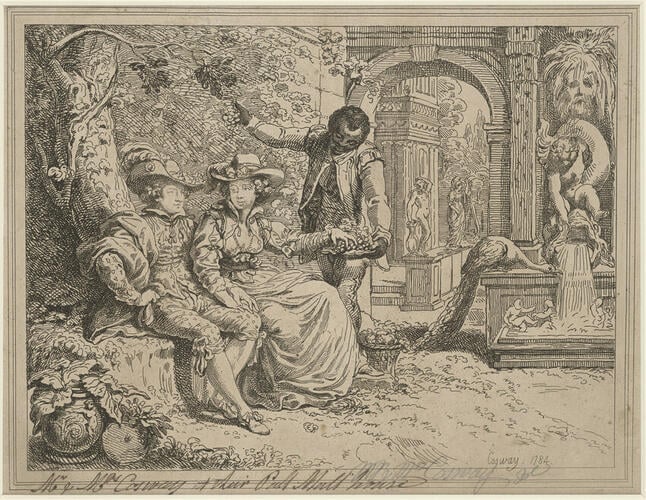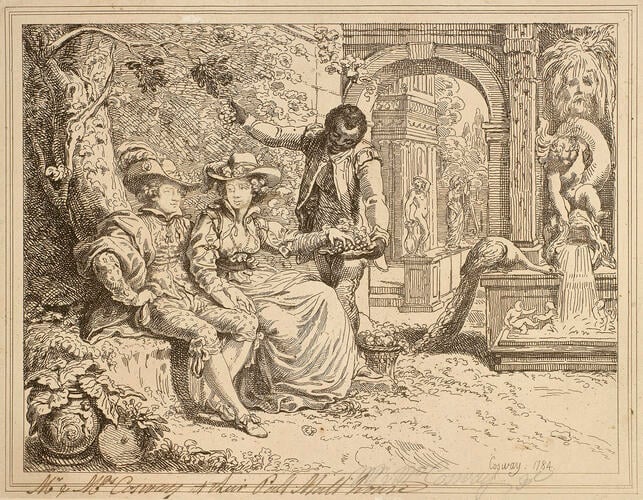Richard Cosway, Maria Cosway and Ottobah Cugoano dated 1784
Etching | 24.5 x 31.5 cm (sheet of paper) | RCIN 653010
-
An etching of a scene in an elegant garden in which Richard Cosway sits with his wife Maria beneath a tree. In the centre Ottobah Cugoano stands proffering grapes to Maria. To the right of the group a peacock drinks from a fountain. A classical arch leads to statuary beyond. Proof, 1st state before the addition of an aquatint border; etched in the plate: Cosway: 1784; inscribed below, in pen: Mr & Mrs Cosway at their Pall Mall house; and in pencil: Mr & Mrs Cosway, &c.
Although this work bears the name Cosway in the plate, Nicholas Knowles has recently suggested a convincing attribution to Thomas Rowlandson.
Richard Cosway is depicted seated with his wife Maria (RCIN 653011) and their servant Ottobah Cugoano, supposedly in the garden of Schomberg House in Pall Mall, to which they had moved in 1784, the date of the print. The composition is a homage to two celebrated marital self-portraits by Peter Paul Rubens (both now in the Alte Pinakothek, Munich): the so-called Honeysuckle Bower, depicting Rubens and his first wife, Isabella Brant, seated beneath foliage, and the Walk in the Garden, in which the artist is seen strolling with his second wife, Helena Fourment, and son Nicolas in the garden of his house in Antwerp. Here Cosway and Maria are shown in essentially the same costume as Rubens and Fourment in the second painting and, although the layout of the garden of Schomberg House at this date is not known in any detail, it is likely that the depiction is idealised to echo the classical architecture and statuary and prominent peacock of Rubens’s painting. Cosway found a constant source of inspiration in Rubens, whose sense of luxuriant courtly swagger perfectly suited the later artist, Principal Painter to the Prince of Wales from 1785.
Ottobah Cugoano was born around 1757 in present-day Ghana. He was enslaved in 1770 and transported to the Caribbean. Two years later he was taken to England where he won his freedom following the Somerset case of 1772, which ruled that chattel enslavement was not supported by common law in England and Wales. He was baptised as ‘John Stuart’ in 1773 and although the next few years of his life are obscure, he had evidently entered the service of Richard and Maria Cosway by 1784. This position provided Cugoano with an introduction to London society and he became active as a prominent abolitionist campaigner, forming a group called the ‘Sons of Africa’, writing to influential figures including George III and the Prince of Wales and in 1787 publishing his Thoughts and Sentiments on the Evil and Wicked Traffic of the Slavery and Commerce of the Human Species. The role of this substantial personality in this etching is more than just as a decorative foil to the artist and his wife, in the traditional manner of Black servants depicted in European portraiture from the sixteenth century onwards; he is on the same scale as his employers and interacts with them elegantly rather than subserviently, standing over Maria and handing her a bunch of grapes as if he were an angel in a composition of the Rest on the Flight into Egypt.
Text adapted from Portrait of the Artist, London, 2016Provenance
Purchased by George IV when Prince Regent from Colnaghi and Co. for 5 shillings, 12 July 1813 (Royal Archives, GEO/MAIN/27932)
-
Creator(s)
Acquirer(s)
-
Medium and techniques
Etching
Measurements
24.5 x 31.5 cm (sheet of paper)
Category
Object type(s)
Other number(s)
Alternative title(s)
Mr and Mrs Cosway at their Pall Mall House











